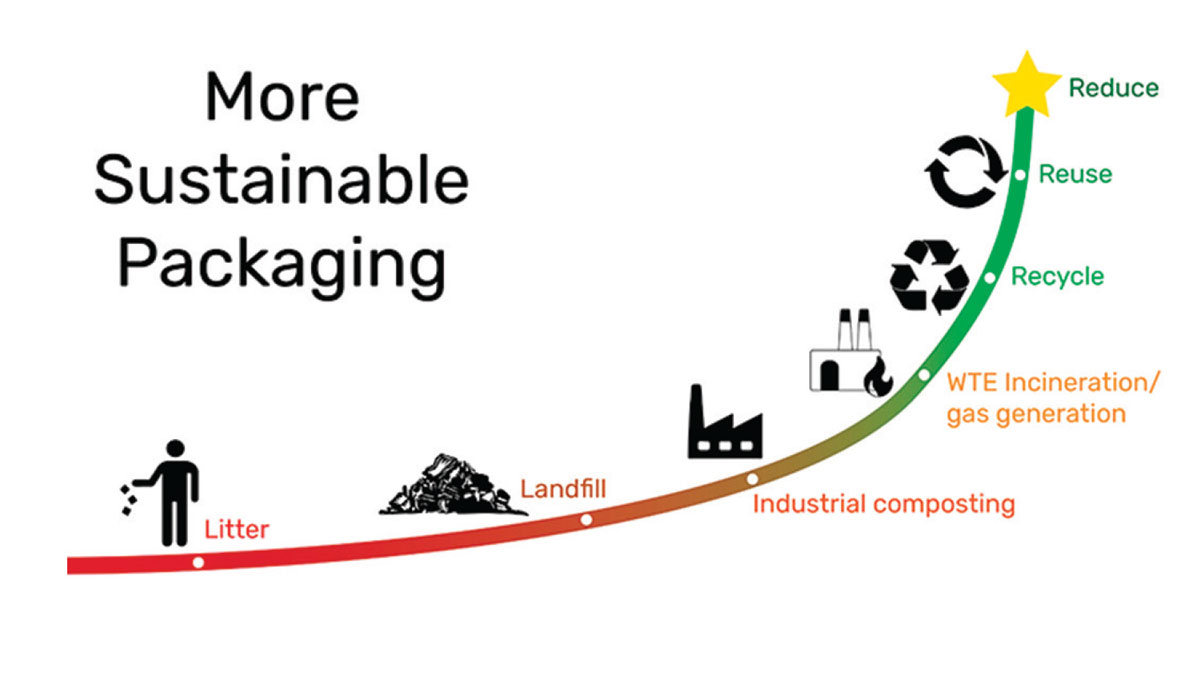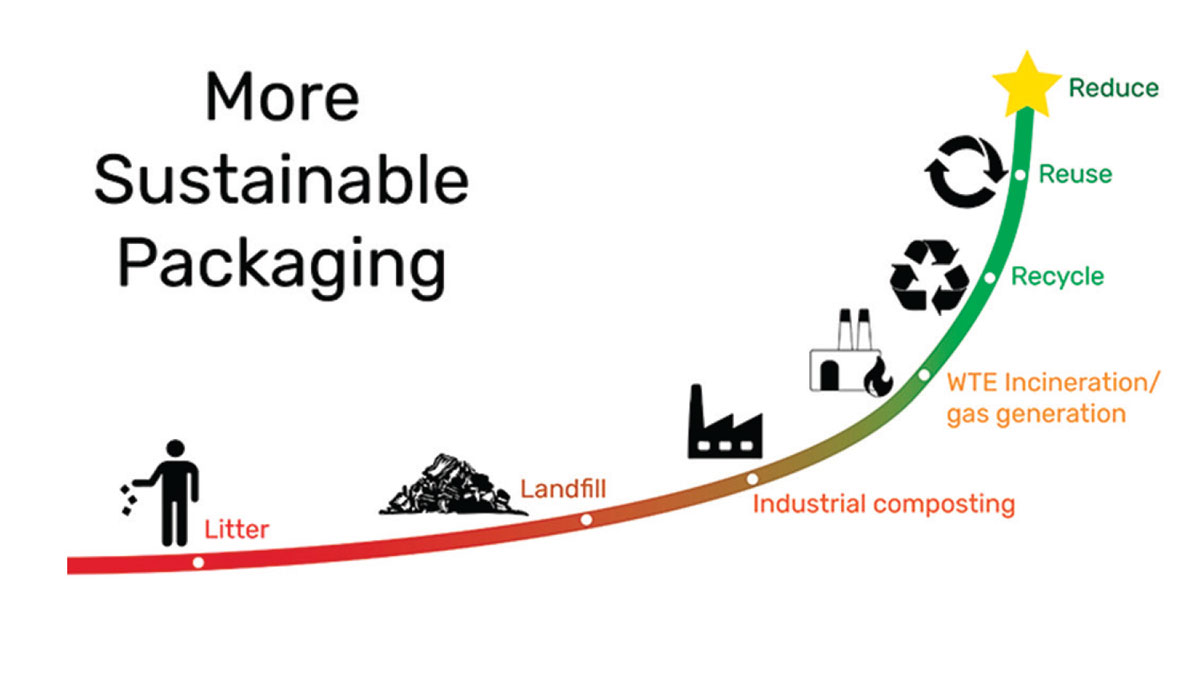Less Packaging, More Sustainability
Packaging | APPLIED SCIENCE
Whether food packaging is made from fossil fuels, plants, agricultural waste, sand, or any other material, less is more when it comes to delivering more sustainable packaging. Packaging reduction means less need for municipal solid waste systems to collect and sort packaging before it is recycled, reused, incinerated, used to generate energy, composted, or landfilled. It is critical to reduce packaging without increasing food waste because the environmental impact of growing, harvesting, transporting, and processing food frequently exceeds the environmental impact of the packaging. This driving force for reducing the amount of packaging continues to be high, and four motivating factors are:
Cost. Higher prices for packaging are prompting brands to reengage with packaging reduction efforts to reduce costs.
Environmental. Calvin Lakhan of York University’s Faculty of Environmental and Urban Change connects the role of packaging reduction to a more sustainable food system. “It’s important to remember that ‘Reduce, Reuse, Recycle’ is not just a catchy phrase,” he says, “but the order in which we are supposed to do things. Reduction of packaging achieves the very first of the three Rs to reduce the amount of packaging waste we generate. The benefits of durability, transport, and ease of consumption can also be attributed to the adoption of lightweight packaging. Lighter and more flexible packaging also means lower greenhouse gas emissions from transportation because more material can be transported safely per shipment.”
Legislative. Legislation such as the European Packaging and Packaging Waste Directive, slated for 2024 enactment, sets waste reduction targets of 5% by 2030, 10% by 2035, and 15% by 2040. Critically, Article 9 states that packaging must be “scaled down” to the bare minimum of size, weight, volume, and layers required to ensure the product’s functionality and safety. As more nations move toward extended producer responsibility (EPR) legislation, more brands will likely focus on reduction since they will be required to share in the cost of packaging disposal. Similarly, California state legislation, CA SB54, focuses on meeting recycling rates and reducing plastic packaging. Legislation restricting nonfunctional slack-fill also serves to reduce the amount of packaging.
Changing Supply Chain. Climate-related disasters and factory slow- and shutdowns to control the spread of COVID-19 have led to altered supply chain and sourcing dynamics that adversely affect the supply of packaging materials. Using less packaging makes these raw materials stretch further.
Lightweighting Lights the Way
Lightweighting, or thinning of the package walls, and rightsizing, or converting packaging to an optimum size, are processes that are helping food companies reduce packaging and realize sustainability goals. “Corrugated boxes have led the way in terms of source reductions of materials via a strategy of ‘lightweighting’ and ‘rightsizing’ of boxes,” says Myles Cohen, founder of Circular Ventures, LLC, and a past president of two of the largest global packaging companies. “With nearly 40 million tons of corrugated boxes used in the United States alone each year, reducing the amount of paper used by corrugated can significantly reduce the environmental impact of packaging.”
Cohen notes that corrugated box manufacturers are now designing the three plies required to make containers with lighter-weight paper grades. “For example, replacing a ply of 35 lb paper with a ply of 26 lb paper resulted in a 25% paper savings,” he says. “This is especially true in the case of e-commerce. Lightweighting is responsible for Amazon’s 30%-plus reduction in packaging.”
Rightsizing corrugated cases results in significant environmental benefits, as well. Less fuel is consumed and emissions are reduced due to fewer trucks and less void-fill packaging. Critically, proper box sizing results in more boxes per pallet, and thus more boxes per trailer load of e-commerce shipments, which means more boxes can fit in delivery vans.
“Over the last two years, one solution—automated, on-demand, box-making equipment on-site at e-commerce facilities—has resulted in right-sized boxes,” Cohen adds. “This technology primarily employs high-speed cameras, artificial intelligence, and a machine that creates a customized on-demand box for every order. This is fast, with up to 15 custom boxes filled per minute. EVO! Cut-it by Ranpak is a cutting-edge solution for this new technology.”
Furthermore, because the dimensional weight (the relationship of shipping box size to total package weight) declines, e-commerce shipping costs are reduced. Interestingly, this case optimization corresponds to brick-and-mortar retailers’ need for drastically different multipacks to alleviate labor constraints in shelf restocking. This strikes an agile balance between direct-store delivery and traditional retail distribution systems. It can be tailored to specific locations, weather changes, and events. For example, different-sized cases can contain various single-serve yogurts at a downtown retailer in St. Paul, Minn. during the winter carnival versus on game day in Auburn, Ala. In addition, this reduces packaging because only the product required at the time is shipped and stocked.
Lightweighting of polyethylene terephthalate (PET) bottles has reduced the amount of plastic in ketchup, salad dressing, and soda bottles by 50%, according to analysis. PET lightweighting focuses on increasing crystallinity by fine-tuning processing speeds, temperatures, extension ratios, molecular weight, molecular weight distribution, and other processing changes. The bottle’s finish, which is still the thickest component, must be strong enough to withstand the high seal torques. Amcor Quantum technology reduces the finish area resulting in 13% less PET in a 12 oz bottle. Structural additives are also used to lightweight packaging. For example, the addition of starch into pouches reduces the amount of packaging by 25% and paper supports a thin bio-based polyethylene furanoate (PEF) liner within a Carlsberg bottle.
While films are often associated with lightweight packaging, using an upgraded cavitation agent to create void spaces within PE film reduces film density and the amount of PE in film by 35%. The 0.1–10 micrometer-sized air voids created by Void Technologies diffract light, resulting in an opaque film that reduces light-induced oxidation. Critically, the technology enables the rapid sink/float separation used in recycling sorting.
Redesigning for Function
Redesign includes the re-exploration of the function of packaging. This is critical because consumers and supply chains have altered dramatically. And package redesign is best done when packaging optimization is scheduled.
Rob Kaszubowski, principal of packaging optimization with Chainalytics, elaborates, noting that recent supply and value chain disruptions have dramatically shifted how food and its packaging are produced, handled, stored, and shipped. “This is a golden opportunity,” he says. “Companies should review their portfolios every 12 to 18 months and have package reevaluations scheduled for after product launch to ensure packaging is optimized.”
Kaszubowski explains that due to the compressed timeline for new product launches and packaging order lead times, packaging designs and materials can be overengineered to ensure a successful launch and entry into the market. But, he notes, taking the time to reevaluate shows that packaging can be reduced. “For example, an increase in production volume and subsequent increases in packaging material costs prompted a frozen food manufacturer to reconsider its packaging,” he says. “This reevaluation resulted in a 9% reduction in primary packaging material. Similarly, shipping case optimization removed a no-longer-required corrugated additive. This reassessment resulted in fewer chemicals being required in packaging as well as increased sourcing flexibility.”
Distribution packaging redesign innovation also can help to reduce the amount of packaging used. Thick pallet corner posts, for example, are commonly used to contain shipping cases on double-stacked pallets, along with either full pallet stretch wrap, shrink wrap, or strapping. When RapidRoperPlus replaces these traditional solutions, packaging can be reduced by 95%, according to the company.
“The system is composed of two layers of prestretched film reinforced with laminated filaments under tension,” explains Bob Kayser, senior vice president, Allied Packaging Corp. “As a result of the high force tension, much of the remaining elasticity of the film is removed, allowing the load to tolerate sudden shifts and continuous vibration while maintaining load stability.” This is critical in the long-distance and erratic global transit of fruits and vegetables, he adds.
The removal of a packaging component also can result in significant packaging reduction. For example, etching or engraving information directly onto beverage bottles allows labels on glass and plastic bottles to be removed. Labels also can be removed from cans using direct digital printing onto the cans themselves. Tonejet’s Cyclone C4+, for example, replaces the pressure-sensitive labels and shrink sleeves common in microbreweries’ short-run beers. This ensures that cans also are recyclable. Another example of component removal is the removal of the “tin-tie” on Hostess brand Donette bags, which the company calculated resulted in an annual savings of 215,000 lbs of steel, 151,000 lbs of plastic, and 700 lbs of glue, lowering the environmental impact of its packaging by an estimated 600,000 kg CO2-eq.






